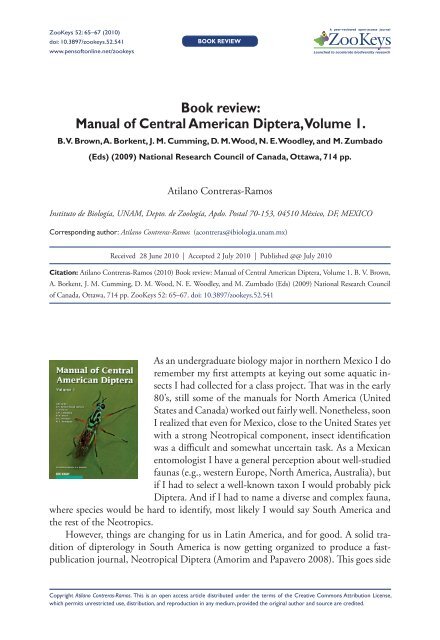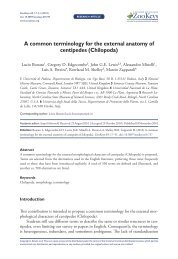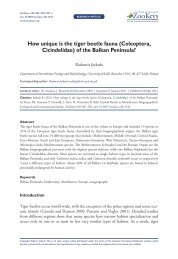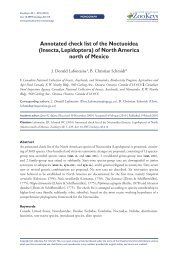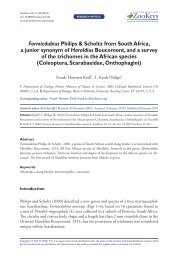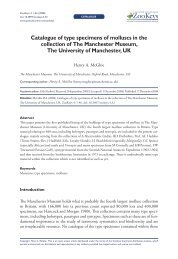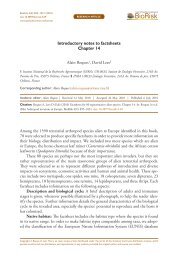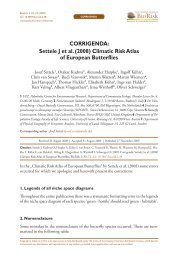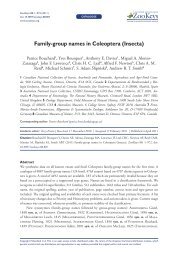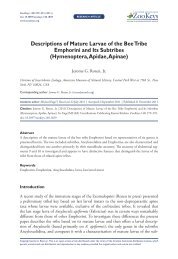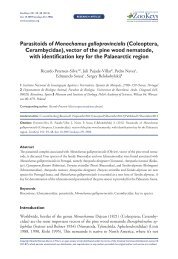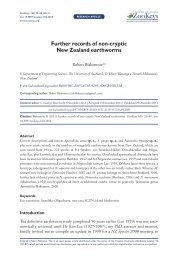Manual of Central American Diptera, Volume 1. - Pensoft Publishers
Manual of Central American Diptera, Volume 1. - Pensoft Publishers
Manual of Central American Diptera, Volume 1. - Pensoft Publishers
Create successful ePaper yourself
Turn your PDF publications into a flip-book with our unique Google optimized e-Paper software.
ZooKeys 52: 65–67 (2010)<br />
doi: 10.3897/zookeys.52.541<br />
www.pens<strong>of</strong>tonline.net/zookeys<br />
Book review: <strong>Manual</strong> <strong>of</strong> <strong>Central</strong> <strong>American</strong> <strong>Diptera</strong>, <strong>Volume</strong> 1 65<br />
BOOK REVIEW<br />
Book review:<br />
<strong>Manual</strong> <strong>of</strong> <strong>Central</strong> <strong>American</strong> <strong>Diptera</strong>, <strong>Volume</strong> <strong>1.</strong><br />
B. V. Brown, A. Borkent, J. M. Cumming, D. M. Wood, N. E. Woodley, and M. Zumbado<br />
(Eds) (2009) National Research Council <strong>of</strong> Canada, Ottawa, 714 pp.<br />
Atilano Contreras-Ramos<br />
Instituto de Biología, UNAM, Depto. de Zoología, Apdo. Postal 70-153, 04510 México, DF, MEXICO<br />
Corresponding author: Atilano Contreras-Ramos ( acontreras@ibiologia.unam.mx )<br />
Received 28 June 2010 | Accepted 2 July 2010 | Published @@ July 2010<br />
A peer-reviewed open-access journal<br />
Launched to accelerate biodiversity research<br />
Citation: Atilano Contreras-Ramos (2010) Book review: <strong>Manual</strong> <strong>of</strong> <strong>Central</strong> <strong>American</strong> <strong>Diptera</strong>, <strong>Volume</strong> <strong>1.</strong> B. V. Brown,<br />
A. Borkent, J. M. Cumming, D. M. Wood, N. E. Woodley, and M. Zumbado (Eds) (2009) National Research Council<br />
<strong>of</strong> Canada, Ottawa, 714 pp. ZooKeys 52 : 65 – 67 . doi: 10.3897/zookeys.52.541<br />
As an undergraduate biology major in northern Mexico I do<br />
remember my fi rst attempts at keying out some aquatic insects<br />
I had collected for a class project. Th at was in the early<br />
80’s, still some <strong>of</strong> the manuals for North America (United<br />
States and Canada) worked out fairly well. Nonetheless, soon<br />
I realized that even for Mexico, close to the United States yet<br />
with a strong Neotropical component, insect identifi cation<br />
was a diffi cult and somewhat uncertain task. As a Mexican<br />
entomologist I have a general perception about well-studied<br />
faunas (e.g., western Europe, North America, Australia), but<br />
if I had to select a well-known taxon I would probably pick<br />
<strong>Diptera</strong>. And if I had to name a diverse and complex fauna,<br />
where species would be hard to identify, most likely I would say South America and<br />
the rest <strong>of</strong> the Neotropics.<br />
However, things are changing for us in Latin America, and for good. A solid tradition<br />
<strong>of</strong> dipterology in South America is now getting organized to produce a fastpublication<br />
journal, Neotropical <strong>Diptera</strong> (Amorim and Papavero 2008). Th is goes side<br />
Copyright Atilano Contreras-Ramos. This is an open access article distributed under the terms <strong>of</strong> the Creative Commons Attribution License,<br />
which permits unrestricted use, distribution, and reproduction in any medium, provided the original author and source are credited.
66<br />
Atilano Contreras-Ramos / ZooKeys 52: 65–67 (2010)<br />
by side with the goal <strong>of</strong> having a <strong>Manual</strong> <strong>of</strong> Neotropical <strong>Diptera</strong>, a challenging job.<br />
Th e Neotropics hold about 25,000 described fl y species (Amorim and Papavero 2008),<br />
which would be about 21% <strong>of</strong> the world <strong>Diptera</strong> fauna <strong>of</strong> 120,000 species (Grimaldi<br />
and Engel 2005), a pretty respectable fi gure. Meanwhile, a subsection <strong>of</strong> Neotropical<br />
fl y diversity has become manageable in the form <strong>of</strong> a <strong>Manual</strong> <strong>of</strong> <strong>Central</strong> <strong>American</strong><br />
<strong>Diptera</strong> (MCAD), an intended two-volume set, <strong>of</strong> which the second one will become<br />
available any time.<br />
Th e MCAD will treat 106 families in the region, <strong>of</strong> which 42 have been included in<br />
volume <strong>1.</strong> Th e area <strong>of</strong> coverage for the manual is circumscribed from Panama to Guatemala<br />
and Belize, plus tropical Mexico (the Yucatan, southeastern Mexico, through<br />
both coastal lines, the Balsas Depression south <strong>of</strong> the Volcanic Axis, and the tip <strong>of</strong> the<br />
Baja California Peninsula). <strong>Volume</strong> 1 includes seven condensed introductory chapters,<br />
corresponding to an introduction, adult morphology and terminology, natural history,<br />
economic importance, phylogeny, key to families for adults, and key to families for<br />
larvae. A total <strong>of</strong> 45 specialists authored the diff erent chapters, <strong>of</strong> which only 6 are<br />
based in Latin America; the rest are based in Australia (1), Europe (12), United States<br />
and Canada (25). Th is speaks <strong>of</strong> the need to stimulate entomology in Latin America, a<br />
role this book for sure will have to a decent share.<br />
As its ancestor, the 3 volume series <strong>Manual</strong> <strong>of</strong> Nearctic <strong>Diptera</strong> (MND; McAlpine<br />
et al. 1981, 1987, 1989), the MCAD has excellent illustrations, many taken from<br />
the MND. Chapter 2 on adult morphology is a delicacy for current and potential<br />
dipterists. It is organized in the form <strong>of</strong> seriated glossaries, following a body region<br />
arrangement. Th is seems to be a more straightforward fashion <strong>of</strong> presenting complex<br />
information that might be arid in regular prose. Th ere is no chapter on larval morphology,<br />
however chapter 7 on a key to families for larvae might cover some <strong>of</strong> that need.<br />
Th e preceding chapter on a key to families for adults is complemented at the end with<br />
nice color photographs <strong>of</strong> habitus <strong>of</strong> each fl y family.<br />
Th e chapter on phylogeny is a succinct, yet quite complete synthesis <strong>of</strong> the relationships<br />
<strong>of</strong> <strong>Diptera</strong> major groups and families. It sacrifi ces, <strong>of</strong> course, much <strong>of</strong> the<br />
detail in volume 3 <strong>of</strong> the MND, such as the extensive character discussion. Both treatments<br />
are fairly concordant, however some diff erences are more or less evident in the<br />
MCAD (e.g., Nematocera is explicitly paraphyletic as Brachycera is sister to Anisopodidae;<br />
phylogeny <strong>of</strong> Brachycera is better resolved and it contains Schizophora, so it is<br />
explicitly paraphyletic).<br />
Th e title <strong>of</strong> each family chapter includes the taxon Latin name followed by common<br />
names in English and Spanish. Each chapter is to be praised. Th ey include sections<br />
on diagnosis, biology, classifi cation, identifi cation, a key to genus, and synopsis<br />
<strong>of</strong> the fauna. A strong eff ort to synthesize available information on a previously mostly<br />
untreated fauna is worth recognizing, especially for highly diverse groups. Th e emphasis<br />
is on adults, however most chapters include at least some illustrations <strong>of</strong> immatures,<br />
some include keys to larvae (e.g., Simuliidae), others include expansion <strong>of</strong> coverage<br />
area (e.g., Nearctic Mexico, in Simuliidae and Stratiomyidae).
Book review: <strong>Manual</strong> <strong>of</strong> <strong>Central</strong> <strong>American</strong> <strong>Diptera</strong>, <strong>Volume</strong> 1 67<br />
Taxonomic chapters correspond to nematocerous families (23) and lower brachycerous<br />
families (19). Of the former, one is an unplaced group within Sciaroidea (the<br />
Ohakunea group), and in the latter, the Mythicomyiidae is recognized as a distinct<br />
family out <strong>of</strong> Bombyliidae. Many families are shared with the Nearctic fauna, yet several<br />
are not included in the MND (i.e., the nematocerous Ditomyiidae, Diadociidae,<br />
Keroplatidae, Lygistorrhinidae, and the brachycerous Pantophthalmidae), some are<br />
surprisingly present (e.g., Ptychopteridae). Th is manual will for sure increase noticeably<br />
the amount <strong>of</strong> works on <strong>Diptera</strong> species in the region, not only taxonomic, but<br />
also ecological and biological. <strong>Volume</strong> 1 is a more than welcome addition to the library<br />
<strong>of</strong> any dipterist, broad minded entomologist, or naturalist, and should be present in<br />
university libraries throughout the region. Meanwhile, volume 2 is anxiously awaited<br />
for the completion <strong>of</strong> the set. Th is book may be acquired through the online bookstore<br />
<strong>of</strong> the National Research Council <strong>of</strong> Canada (http://pubs.nrc-cnrc.gc.ca/eng/books/<br />
browse/list-0-0.html).<br />
References<br />
Amorim DS, Papavero N (2008) Editorial. A journal for the systematics and biogeography <strong>of</strong><br />
Neotropical <strong>Diptera</strong>, 250 years after the publication <strong>of</strong> the tenth edition <strong>of</strong> the Systema<br />
Naturae. Neotropical <strong>Diptera</strong> 1: 1–5.<br />
McAlpine JF, Peterson BV, Shewell GE, Teskey HJ, Vockeroth JR, Wood DM (Eds) (1981)<br />
<strong>Manual</strong> <strong>of</strong> Nearctic <strong>Diptera</strong>, vol. <strong>1.</strong> Research Branch, Agriculture Canada, Monograph<br />
No. 27, Ottawa, 674 pp.<br />
McAlpine JF, Peterson BV, Shewell GE, Teskey HJ, Vockeroth JR, Wood DM (Eds) (1987)<br />
<strong>Manual</strong> <strong>of</strong> Nearctic <strong>Diptera</strong>, vol. 2. Research Branch, Agriculture Canada, Monograph<br />
No. 28, Ottawa, pp. 675–1332.<br />
McAlpine JF, Wood DM (Eds) (1989) <strong>Manual</strong> <strong>of</strong> Nearctic <strong>Diptera</strong>, vol. 3. Research Branch,<br />
Agriculture Canada, Monograph No. 32, Ottawa, pp. 1333–158<strong>1.</strong>


